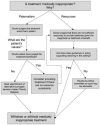Knowing when to stop: futility in the ICU
- PMID: 21293267
- PMCID: PMC3252683
- DOI: 10.1097/ACO.0b013e328343c5af
Knowing when to stop: futility in the ICU
Abstract
Purpose of review: Decisions to withdraw or withhold potentially life-sustaining treatment are common in intensive care and precede the majority of deaths. When families resist or oppose doctors' suggestions that it is time to stop treatment, it is often unclear what should be done. This review will summarize recent literature around futility judgements in intensive care emphasising ethical and practical questions.
Recent findings: There has been a shift in the language of futility. Patients' families often do not believe medical assessments that further treatment would be unsuccessful. Attempts to determine through data collection which patients have a low or zero chance of survival have been largely unsuccessful, and are hampered by varying definitions of futility. A due-process model for adjudicating futility disputes has been developed, and may provide a better solution to futility disputes than previous futility statutes.
Summary: Specific criteria for unilateral withdrawal of treatment have proved hard to define or defend. However, it is ethical for doctors to decline to provide treatment that is medically inappropriate or futile. Understanding the justification for a futility judgement may be relevant to deciding the most appropriate way to resolve futility disputes.
Figures
References
-
- Le Conte P, Riochet D, Batard E, et al. Death in emergency departments: a multicenter cross-sectional survey with analysis of withholding and withdrawing life support. Intensive Care Med. 2010;36:765–772. - PubMed
-
- Finley Caulfield A, Gabler L, Lansberg MG, et al. Outcome prediction in mechanically ventilated neurologic patients by junior neurointensivists. Neurology. 2010;74:1096–1101. - PMC - PubMed
-
* Study of the relationship between predicted and actual outcome for patients (ventilated for at least three days) in a single neurosurgical-intensive care unit.
-
- Brieva JL, Cooray P, Rowley M. Withholding and withdrawal of life-sustaining therapies in intensive care: an Australian experience. Crit Care Resusc. 2009;11:266–268. - PubMed
-
- Spronk PE, Kuiper AV, Rommes JH, et al. The practice of and documentation on withholding and withdrawing life support: a retrospective study in two Dutch intensive care units. Anesthesia and analgesia. 2009;109:841–846. - PubMed
Publication types
MeSH terms
Grants and funding
LinkOut - more resources
Full Text Sources
Medical
Research Materials



